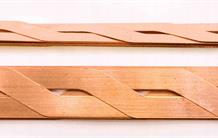A dipole magnet, built by a European collaboration involving IRFU from high-temperature superconductors, has produced a 4.5 tesla magnetic field, which is one tesla higher than previous prototypes. Once inserted in a Niobium-Tin dipole magnet, the whole system will produce an 18 T field.
The beams of particles at the LHC are curved by more than 1,000 dipole magnets fifteen meters long. Thanks to their superconducting niobium-titanium winding, cooled to 1.9 K, they produce an 8.3 T magnetic field.
The successors of the LHC, the high-energy LHC (HE-LHC) and the future circular collider (FCC), will need niobium-tin dipole magnets (Nb3Sn) of 16 T, or even 20 T, when associated with high-temperature superconducting magnets (HTS).
Several teams from IRFU take part in this R&D, with the objective to produce an additional magnetic field with a dipole magnet manufactured from HTS ceramic wrap, itself inserted in a niobium-tin dipole magnet. More precisely, the HTS dipole would add 5 T to the 13 T of the Nb3Sn magnet.
A record magnetic field of 4.52 T was obtained at the center of a prototype dipole wound with a REBCO ceramic material (Rare Earth Barium Copper Oxide) during tests in liquid helium tank. Which was one tesla higher than the last known record!
This work was completed in collaboration with CNRS in Grenoble, France, INFN in Milan, Italy, Tampere University in Finland, and CERN. The American company SuperPower supplied the YBCO superconducting ribbon (barium, copper and yttrium oxides).
Contacts : Maria Durante
• superconducting magnet physics and technology
• Accelerators, Cryogenics and Magnetism Division (DACM) • The Systems Engineering Division
• LEAS




